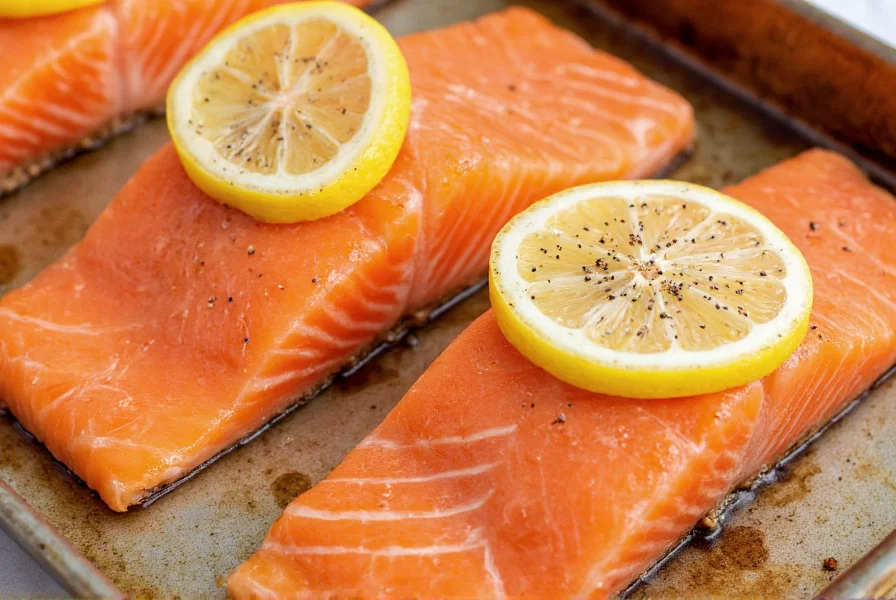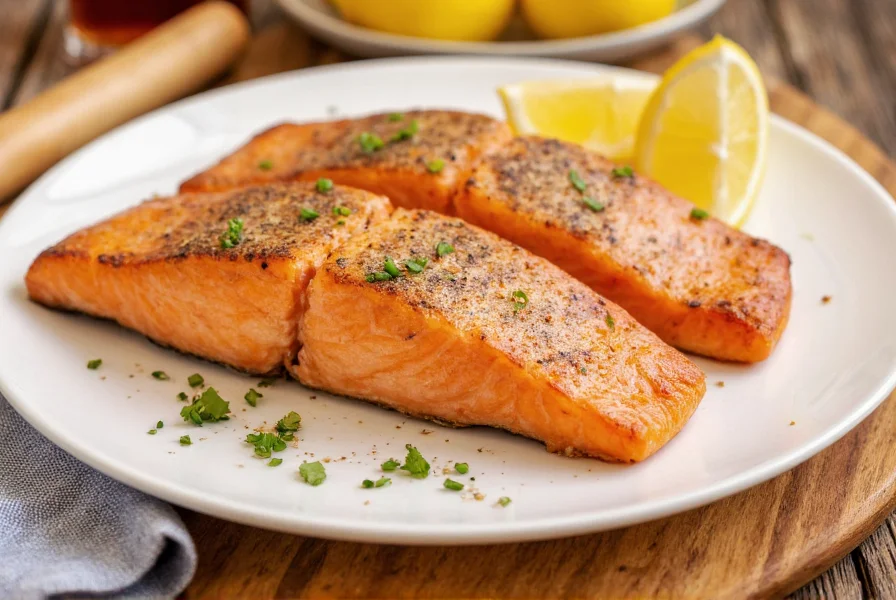Lemon and pepper salmon stands as one of the most versatile and accessible seafood preparations for home cooks. This classic combination transforms humble salmon fillets into a restaurant-quality meal with minimal effort. The bright acidity of lemon perfectly complements salmon's rich oiliness, while freshly cracked black pepper adds subtle warmth without overwhelming heat. What makes this preparation exceptional is its balance—neither ingredient dominates, creating a harmonious flavor profile that appeals to both seafood enthusiasts and those new to cooking fish.
Why This Recipe Works
The magic of lemon and pepper salmon lies in its simplicity and the quality of just a few key ingredients. Unlike complex recipes requiring specialty items, this preparation highlights how premium ingredients need minimal intervention to shine. Fresh salmon contains natural oils that carry flavors beautifully, while the citric acid in lemon helps break down proteins slightly, tenderizing the fish as it cooks.
Professional chefs consistently return to this preparation because it demonstrates a fundamental cooking principle: let quality ingredients speak for themselves. When selecting salmon, look for firm flesh with a vibrant color and clean ocean scent—avoid any fish with brown spots or ammonia-like odors. Wild-caught salmon typically offers more complex flavor than farm-raised varieties, though both work well in this recipe.
Essential Ingredients for Perfect Lemon Pepper Salmon
Creating exceptional lemon and pepper salmon requires attention to ingredient quality and proportions. Here's what you'll need for four servings:
| Ingredient | Quantity | Key Selection Tips |
|---|---|---|
| Salmon fillets | 4 (6 oz each) | Skin-on preferred for moisture retention |
| Fresh lemon | 1 large | Organic preferred for zest |
| Freshly cracked black pepper | 1–1½ tsp | Coarse grind for best flavor release |
| Extra virgin olive oil | 1½ tbsp | High quality for finishing |
| Kosher salt | ¼ tsp | Enhances natural flavors |

Step-by-Step Preparation Guide
Follow these precise steps for consistently perfect lemon pepper salmon every time:
- Preparation: Remove salmon from refrigerator 15 minutes before cooking. Pat fillets thoroughly dry with paper towels—this critical step ensures proper searing and prevents steaming.
- Seasoning: Place salmon skin-side down on parchment-lined baking sheet. Drizzle with 1 tbsp olive oil, then rub evenly across surface. Sprinkle with salt and freshly cracked pepper. Using a microplane, zest half the lemon directly over fish, then slice remaining lemon into thin rounds for garnish.
- Cooking: Preheat oven to 400°F (200°C). Bake salmon for 12-15 minutes depending on thickness. The fish is done when it reaches 125°F internally and flakes easily with fork, but still appears slightly translucent in center (it will continue cooking off-heat).
- Finishing: Remove from oven and immediately drizzle with remaining ½ tbsp olive oil and 1 tbsp fresh lemon juice. Let rest 3 minutes before serving—this allows residual heat to finish cooking while keeping moisture intact.
Proven Cooking Techniques for Best Results
Achieving restaurant-quality lemon pepper salmon at home requires understanding several key techniques:
- Dry surface is essential: Moisture creates steam rather than allowing proper browning. Always pat fish completely dry before seasoning
- Temperature matters: Never cook salmon straight from refrigerator. Allowing it to come closer to room temperature ensures even cooking
- Don't overcook: Salmon continues cooking after removal from oven. Remove at 125°F for medium-rare (ideal texture) as it will reach 130°F during resting
- Fresh pepper makes difference: Pre-ground pepper loses volatile oils. Invest in a pepper mill for noticeably better flavor
Serving Suggestions and Pairings
Lemon pepper salmon's bright flavor profile pairs beautifully with numerous side dishes. For a complete meal that balances textures and flavors:
- Grain bases: Lemon herb quinoa, wild rice pilaf, or orzo with roasted vegetables
- Vegetable companions: Roasted asparagus, garlic green beans, or sautéed spinach with pine nuts
- Sauces: Simple dill yogurt sauce or gremolata for added complexity
- Wine pairings: Crisp Sauvignon Blanc or unoaked Chardonnay complement the citrus notes
This dish transitions effortlessly from weeknight dinner to special occasion meal. For entertaining, consider serving individual portions over beds of arugula with shaved fennel and a light vinaigrette for an elegant presentation that requires minimal last-minute effort.
Storage and Reheating Guidelines
While lemon pepper salmon tastes best fresh, proper storage maintains quality for leftovers:
- Refrigeration: Store in airtight container with parchment between layers for up to 2 days
- Reheating: Place on baking sheet and warm at 275°F (135°C) for 8-10 minutes until internal temperature reaches 120°F
- Avoid microwaving: This dries out salmon and creates uneven heating
- Repurposing: Flake leftover salmon into salads, grain bowls, or pasta dishes

Variations for Dietary Preferences
This basic lemon pepper salmon recipe adapts well to various dietary needs:
- Keto adaptation: Serve with roasted low-carb vegetables like zucchini noodles or cauliflower mash
- Gluten-free: Naturally compliant—just verify any pre-made seasoning blends are GF
- Paleo version: Substitute olive oil with avocado oil for higher smoke point
- Spicy variation: Add pinch of red pepper flakes with the black pepper for subtle heat
Frequently Asked Questions
How long should I bake salmon with lemon and pepper?
Bake salmon at 400°F (200°C) for 12-15 minutes, depending on thickness. The fish is properly cooked when it reaches 125°F internally and flakes easily with a fork while still appearing slightly translucent in the center. Remember that salmon continues cooking after removal from the oven during the 3-minute resting period.
Can I use frozen salmon for lemon pepper preparation?
Yes, but proper thawing is essential for best results. Transfer frozen salmon to the refrigerator 24 hours before cooking. Never cook frozen salmon directly as it will cook unevenly. Once thawed, pat thoroughly dry before seasoning—this step prevents excess moisture that would interfere with proper browning and flavor development.
What's the best type of salmon for lemon pepper seasoning?
Both wild-caught and farm-raised salmon work well, though they offer different flavor profiles. Wild-caught salmon typically has a more robust, complex flavor that stands up beautifully to lemon and pepper. Atlantic (farm-raised) salmon has higher fat content, resulting in exceptionally moist results. For beginners, farm-raised provides more margin for error, while experienced cooks often prefer wild-caught for its distinctive taste.
Should I leave the skin on when baking lemon pepper salmon?
Leaving the skin on provides several advantages: it protects the delicate flesh during cooking, helps retain moisture, and creates a crispy texture contrast when properly seared. When serving, the skin easily separates from the flesh if desired. For baking, place salmon skin-side down on the baking sheet. If you prefer skinless salmon, reduce cooking time by 2-3 minutes as the fish will cook faster without the protective skin layer.











 浙公网安备
33010002000092号
浙公网安备
33010002000092号 浙B2-20120091-4
浙B2-20120091-4